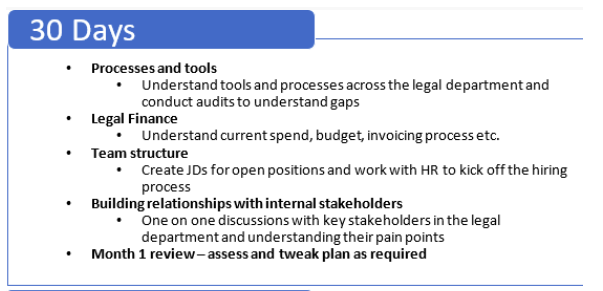Share this
Agile: A Manifesto for Collaborative Thinking?
February 5, 2020

There has been a lot of talk amongst law firms about agile working as a way of improving workflow and collaboration. First employed by the software industry, agile projects are defined by short bursts of work that are intended to produce a deliverable result. However what works in one industry, might not work in another. What has agile come to mean in a legal context?
According to one law library case study, it means working effectively from anywhere in the world for the benefit of clients. In my view this is not ‘agile’ as defined by software engineers, but rather, a flexible work strategy. As one article explained, one term refers to greater flexibility in terms of work/life balance, and the other is about how your organisation approaches workflow.
What is the difference between agile working and agile projects?
These are two very different things. For instance -
- Agile working uses technology to create a new normal pattern of working where all employees can work at different times, from various locations, provided business needs are met. This should result in benefits such as greater employee productivity, decreased office costs and a more motivated workforce.
- An agile project is where research, planning, design, development and testing all happen in parallel. It allows for continuous improvements to be made throughout the process with the new system only going live when it has demonstrated the service works and meets the user's needs.
This is an important distinction to make, and leads me on to the next level of how people perceive agile. For this I went back to the original source - the Manifesto.
Did you know there was a Manifesto for Agile Software Development?
Although legal, for the most part, has embraced flexible working, firms have been slower to adopt an agile philosophy. They are still in the experimental stage because of the major cultural and organisational shift required. But this tweet from Allen Holeb got me thinking about agile and the legal industry, and he prompted me to read the original Manifesto for Agile Software Development, published in 2001.
Allen listed the words that appear, and do not appear, in it:
Words that DO NOT appear in the Agile Manifesto & Principles: |
Words that DO appear in the Agile Manifesto & Principles: |
|
sprint |
individuals |
|
backlog |
interaction |
|
product owner, scrum master |
valuable |
|
release train |
collaboration |
|
story |
change |
|
Story points |
customer |
|
estimate |
deliver…frequently |
|
velocity |
conversation |
|
meeting |
technical excellence |
|
Jira |
simplicity |
|
manager |
self-organizing |
|
productivity |
reflects on…effective |
|
utilization |
adjusts |
This was a revelation to me. When you read all the buzz-wordy articles around agile, it seems managers, commentators and other proponents have become obsessed with following the rules, the ‘how to’ and the process. Ironically the rationale behind the manifesto - the original intentions of these engineers - was to break down corporate ‘make-work and arcane policies’,
In order to succeed in the new economy, to move aggressively into the era of e-business, e-commerce, and the web, companies have to rid themselves of their Dilbert manifestations of make-work and arcane policies...Quite frankly, the Agile approaches scare corporate bureaucrats— at least those that are happy pushing process for process’ sake versus trying to do the best for the "customer" and deliver something timely and tangible and "as promised"—because they run out of places to hide.
Clearly we are back in 2001 - or perhaps we have come full circle. Legal commentators are constantly filling social media with words like collaboration, conversation, reflection, simplicity, and adjust[ments].
So what else can we learn from this Manifesto?
Why should we value individuals and interactions over processes and tools?
'The most efficient and effective method of conveying information to and within a development team is face-to-face conversation' (Principle 6 from the Manifesto)
Generally speaking, we spend our whole life being social, seeking out and enjoying relationships and the companionship of others. Although different situations call for different types of conversations, a productive workplace requires individuals to interact. Perhaps if we had fewer meetings and more conversations at work, we might enjoy a more efficient exchange of information?
Collaboration is the new normal in the workplace; employees need to work together as part of a team. Library and information people, in my view and experience, have always driven connectivity in their organisations (and beyond) because knowledge sharing is what we do. Cataloging and digitisation projects, online public access, 'socializing the project', library consortia - we are always ahead of the curve.
The purpose of collaboration tools is to support people in achieving their goals or objectives. Although they normally take the form of cloud based apps, such as Trello or Wikis, project development and inspiration can just as likely occur over regular ‘water cooler’ moments, FaceTime tea breaks or work socials.
Why we should focus on customer collaboration, rather than contract negotiation
'Business people and developers must work together daily throughout the project' (Principle 4 from the Manifesto)
It is important to recognise that the manifesto is open to interpretation; lawyers would not appreciate being told that contract negotiation isn’t an organisation’s main focus. They should know, lawyers are naturally risk averse and for good reason. Reflecting on what the in-house lawyer said,
Legal acts as a ‘sanity check’. There is a practical reason that they need to know exactly what the business is selling, and how it is being sold. For instance, Sales might want flexibility in contracts with certain customers, however this might have unintended consequences further down the line. The lawyer needs to anticipate risks and explain what could happen. Therefore putting the business at the heart of the legal department is essential.
Despite the importance of negotiations, and whatever the contract says, when you go to a tech company with a problem, you expect them to listen and come up with creative solutions. There are so many possibilities when you collaborate with clients, and as all information people know we are all aiming for the right information, at the right time, and at the right place!
Why we should respond to change over following a plan
'Welcome changing requirements, even late in development. Agile processes harness change for the customer's competitive advantage' (Principle 2 from the Manifesto)
One legal ops manager explained the importance of planning, and outlined a 30/60/90 day plan. She says that it provides structure and prevents her from getting lost. Using a ‘big picture theme’, such as Processes, Legal Finance, Team structure, etc, she then builds tasks to support that theme. This is essential for the smooth running of operations - in any organisation. For example, this is her plan for 30 days,

Most importantly, she gives herself room for assessment and ‘tweaking’. In an agile working environment we are ready to respond appropriately to any new developments because we give ourselves time to reflect and adjust. As the final principle of the manifesto says, 'at regular intervals, the team reflects on how to become more effective, then tunes and adjusts its behavior accordingly'.
Information professionals are by nature agile and flexible, so we already have the mindset to embrace new ways of service delivery. Research, planning, design, development and testing happening in parallel: we must constantly strive to improve collaboration and work to continuously ensure an effective and productive partnership with everyone.
Collaboration means improved efficiency and increased productivity but only if you have the right tools for collaboration in the first place. It also requires a group of employees to work well together. We must look at the way we work with our colleagues to come up with strategies - and explore some of the words and principles in the Agile Manifesto.
Share this
- December 2025 (2)
- November 2025 (2)
- October 2025 (3)
- September 2025 (2)
- August 2025 (2)
- July 2025 (4)
- June 2025 (3)
- May 2025 (2)
- April 2025 (1)
- March 2025 (1)
- October 2024 (1)
- July 2024 (1)
- June 2024 (2)
- May 2024 (2)
- April 2024 (3)
- March 2024 (3)
- February 2024 (4)
- January 2024 (2)
- December 2023 (1)
- November 2023 (2)
- October 2023 (2)
- September 2023 (1)
- August 2023 (3)
- July 2023 (5)
- June 2023 (2)
- May 2023 (2)
- April 2023 (4)
- March 2023 (1)
- February 2023 (1)
- January 2023 (2)
- November 2022 (2)
- September 2022 (2)
- August 2022 (2)
- July 2022 (1)
- June 2022 (1)
- May 2022 (2)
- April 2022 (3)
- March 2022 (1)
- February 2022 (2)
- December 2021 (2)
- November 2021 (2)
- October 2021 (2)
- September 2021 (2)
- August 2021 (2)
- July 2021 (2)
- June 2021 (2)
- May 2021 (1)
- April 2021 (2)
- March 2021 (1)
- February 2021 (3)
- January 2021 (2)
- November 2020 (3)
- October 2020 (1)
- August 2020 (2)
- July 2020 (4)
- June 2020 (1)
- May 2020 (1)
- April 2020 (2)
- March 2020 (2)
- February 2020 (3)
- January 2020 (1)
- December 2019 (2)
- November 2019 (1)
- October 2019 (1)
- September 2019 (1)
- August 2019 (3)
- July 2019 (3)
- June 2019 (3)
- May 2019 (2)
- April 2019 (1)
- March 2019 (2)
- February 2019 (3)
- January 2019 (3)
- December 2018 (1)
- November 2018 (2)
- October 2018 (2)
- September 2018 (1)
- August 2018 (2)
- July 2018 (1)
- June 2018 (2)
- May 2018 (3)
- April 2018 (3)
- March 2018 (1)
- February 2018 (3)
- January 2018 (1)
- November 2017 (1)
- October 2017 (1)
- July 2017 (1)
- April 2017 (2)
- March 2017 (3)
- February 2017 (1)
- January 2017 (1)
- November 2016 (2)
- October 2016 (1)
- September 2016 (1)
- August 2016 (2)
- June 2016 (1)
- May 2016 (1)
- April 2016 (1)
